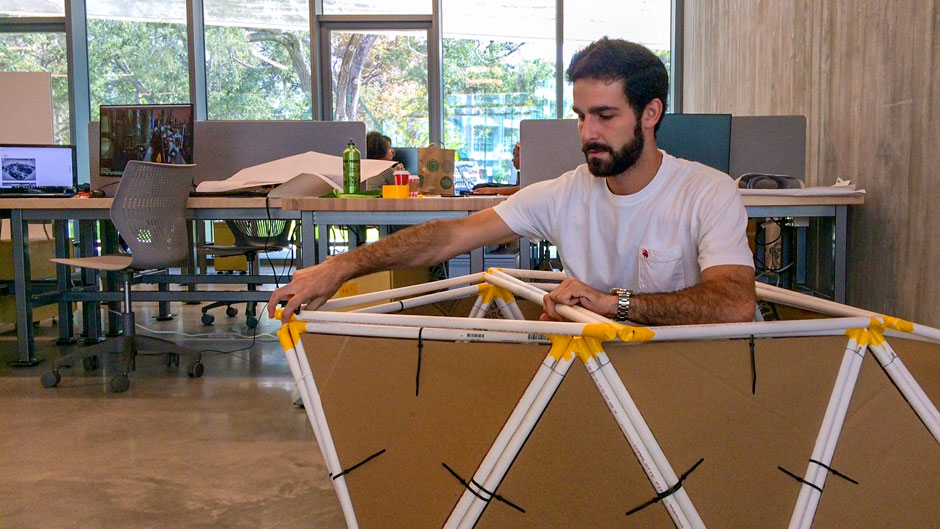The 60-year-old man prefers the streets of Miami over a homeless shelter, sleeping on a park bench some nights, other times under a tree. Fifth-year University of Miami School of Architecture student Felipe Delgado first encountered the man in early September, just as the fall semester was getting underway.
“He told me about how Coconut Grove used to be—the wall that separated the black and white communities,” said Delgado.
But of the many things the two talked about, being exposed to the elements while living on the streets was the man’s biggest concern.
Now, Delgado has created a portable shelter that would give homeless people like the 60-year-old man a place to sleep. Approximately the size of a full refrigerator, it is made of reinforced cardboard held together by PVC pipes and zip ties.
“It’s foldable, strong, and mobile,” said Delgado, who built the prototype for his senior design project in professor Germane Barnes’ upper level studio.
For the fall semester that recently came to a close, Barnes themed his studio on Social Housing in South Florida, challenging his students to conduct research and build structures based on single, multi, and informal living quarters.
For the research component of his project, Delgado visited areas in Miami where the homeless can be found, speaking to about 30 men and women in all.
According to the Miami-Dade County Homeless Trust’s annual Point-in-Time census, more than 3,500 people are homeless in Miami-Dade. “It’s a difficult issue to address,” said Delgado, who also compiled a guidebook on how to construct his portable shelter.
His was not the only project in Barnes’ studio to address a daunting challenge. With sea level rise accelerating around the world, threatening to leave portions of coastal cities underwater in the near future, fourth-year architecture student Kyle Ferry designed Miami housing units that are adaptable to changing climatic conditions, giving them features such as water filtration systems, zip lines that allow residents to travel from one building to the next, and areas for growing crops and raising livestock. He’s also produced an animated film on how his city of the future will operate.
Delgado, Ferry, and other students found Barnes’ fall semester Social Housing in South Florida studio inspiring.
A native of Chicago, Barnes selected the theme of his studio because of his research and design practice, which examines how the built environment influences the social and cultural experience, particularly that of black neighborhoods.
Through his studio, he said, students were exposed to the social and anthropological impact architecture can have through form. “Often architecture tries to remove social responsibility from its ledger,” said Barnes, who, through a grant from the Graham Foundation for Advanced Studies in the Fine Arts, has been traveling the country studying the role of the front porch in the black vernacular. “My goal is to show students that this is impossible and an irresponsible means of practice.”

